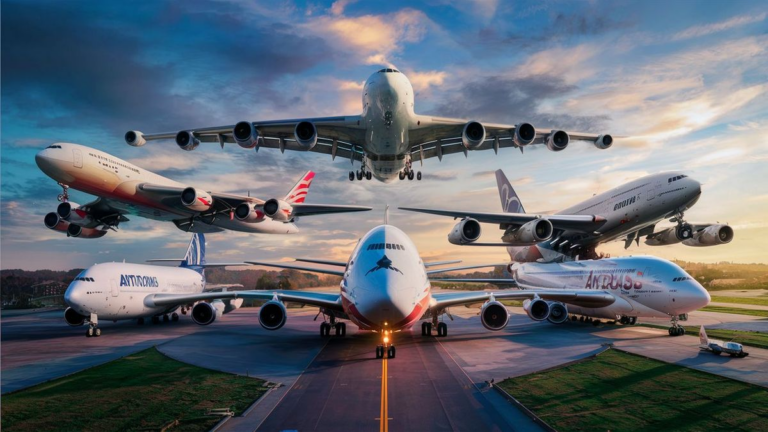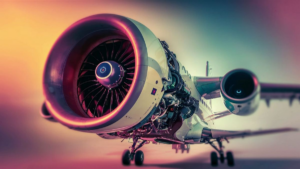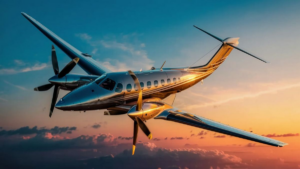When it comes to the marvels of engineering and aviation, the world’s largest aircraft never fail to capture our imagination. From cargo haulers to passenger carriers, these colossal machines push the boundaries of what we thought possible in aviation. Join us as we explore the top 10 largest aircraft in the world, each a testament to human ingenuity and technological prowess.
The Antonov An-225 Mriya
Claiming the title of the largest aircraft in the world by both length and wingspan, the Antonov An-225 Mriya is an absolute behemoth. Originally designed to transport the Soviet Union’s space shuttle, the Buran, this six-engine monster continues to impress with its massive cargo capacity and unparalleled size.
The Airbus A380
As the largest passenger aircraft ever built, the Airbus A380 has redefined air travel on a grand scale. With its double-deck design and seating for hundreds of passengers, it remains a symbol of luxury and comfort in the skies.
The Boeing 747-8
Boeing’s 747 series has long held a place as one of the most iconic aircraft in aviation history, and the 747-8 takes that legacy to new heights. With its elongated fuselage and efficient design, it continues to serve as a versatile platform for both cargo and passenger operations.
The Stratolaunch
Breaking away from conventional aircraft design, the Stratolaunch stands out as a unique entry on our list. With its dual-fuselage configuration and massive wingspan, it serves as a launch platform for satellite delivery systems, pushing the boundaries of aerospace innovation.
The Hughes H-4 Hercules
While it may have only made one brief flight in its lifetime, the Hughes H-4 Hercules, also known as the “Spruce Goose,” remains a legend in aviation history. Constructed primarily from wood due to wartime material shortages, this colossal seaplane still holds the record for the largest wingspan of any aircraft ever flown.
The Antonov An-124 Ruslan
Another entry from Antonov, the An-124 Ruslan, continues to serve as one of the world’s premier heavy-lift cargo aircraft. With its massive payload capacity and rugged design, it plays a crucial role in transporting oversized cargo across the globe.
The Lockheed C-5M Super Galaxy
As one of the largest military transport aircraft in the world, the Lockheed C-5M Super Galaxy plays a vital role in global logistics and military operations. With its cavernous cargo bay and ability to carry oversized equipment, it remains a cornerstone of the United States Air Force’s strategic airlift capability.
The Boeing 777-9
Boeing’s latest addition to its lineup, the 777-9, promises to set new standards for efficiency and passenger comfort. With its advanced aerodynamics and spacious cabin, it represents the future of long-haul air travel.
The Airbus BelugaXL
Designed specifically to transport oversized cargo for Airbus’ manufacturing facilities across Europe, the BelugaXL is a sight to behold. With its bulbous fuselage and distinctive appearance, it stands out among the world’s largest aircraft.
The Boeing Dreamlifter
Completing our list is the Boeing Dreamlifter, a modified version of the 747-400 specifically designed to transport oversized components for Boeing’s Dreamliner aircraft. With its unique swing-tail design and massive cargo capacity, it plays a crucial role in the global aerospace supply chain.
Each of these aircraft represents the pinnacle of engineering achievement, pushing the boundaries of what is possible in the world of aviation. From transporting passengers to delivering oversized cargo, they continue to shape the way we travel and explore the skies.
Frequently Asked Questions
Here are some common questions about the world’s largest aircraft:
| Question | Answer |
|---|---|
| 1. What factors determine the size of an aircraft? | The size of an aircraft is typically determined by its dimensions, including length, wingspan, and height. Payload capacity and purpose, whether for passengers or cargo, also influence its size. |
| 2. How are these large aircraft manufactured? | Manufacturing of large aircraft involves advanced engineering and assembly processes. Materials such as aluminum, composite materials, and in some cases, wood, are used in construction. |
| 3. What are the main uses of the world’s largest aircraft? | The largest aircraft are primarily used for transporting passengers or oversized cargo. They play significant roles in commercial aviation, military operations, and aerospace logistics. |
| 4. How do these aircraft contribute to aviation innovation? | These aircraft push the boundaries of aviation technology and design. They incorporate advanced materials, aerodynamics, and propulsion systems, driving innovation in the aerospace industry. |
| 5. Are there any environmental considerations with these large aircraft? | Efforts are made to improve the environmental performance of large aircraft, including fuel efficiency enhancements and noise reduction measures. However, their significant size and capacity also pose challenges in terms of emissions and environmental impact. |
Future Trends in Large Aircraft
Looking ahead, several trends are shaping the development of large aircraft:
- 1. Efficiency Improvements: Manufacturers are focused on enhancing the fuel efficiency and environmental performance of large aircraft through advanced aerodynamics and propulsion technologies.
- 2. Technological Integration: Integration of cutting-edge technologies such as artificial intelligence, advanced materials, and electric propulsion systems is expected to revolutionize the design and capabilities of future large aircraft.
- 3. Urban Air Mobility: The concept of urban air mobility is gaining traction, leading to the development of large electric-powered aircraft for short-distance transportation within urban areas.
See also:






